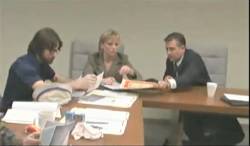Factual error: In the scene in which the scientists observe the emergence of the black hole out in the Lechuguilla desert, as it pokes out of the ground unexpectedly near to their base everything in the tent is shown powerfully accelerating roughly horizontally, toward the object as it whizzes skyward. But, given all the data in the movie(mass = 10^9 kg; it reaches max height of about 1,400 meters above the desert floor before coming back down; it emerges not less than 2 meters outside their tent), it ought to impart a gravitational acceleration of not more than 0.0167 m/s^2, which is only less than two thousandths the force provided by Earth. Given that the hole was also traveling away at about 117 m/s, the relative velocity would've been in excess of the hole's escape velocity(only about 0.25 m/s), so there would be no such dramatic effect. (01:04:40)

The Krone Experiment (2005)
1 factual error - chronological order
Directed by: J. Robinson Wheeler
Starring: Benjamin Pascoe, Darbi Worley, Robert Graham, Tom Weirich
Revealing mistake: In the very first scene, which takes place in a Moroccan sheepherder's meadow, the camera makes some gentle panning motion. The mountains in the distance can be seen noticeably moving not quite in sync with the foreground. The foreground is actually in Texas (according to the director's commentary), and the mountains were added in post production.
Trivia: The scenes in Krone's laboratory were photographed around a real Tokamak machine, which soon afterward was disassembled & shipped to a Chinese university.
Join the mailing list
Separate from membership, this is to get updates about mistakes in recent releases. Addresses are not passed on to any third party, and are used solely for direct communication from this site. You can unsubscribe at any time.
Check out the mistake & trivia books, on Kindle and in paperback.



